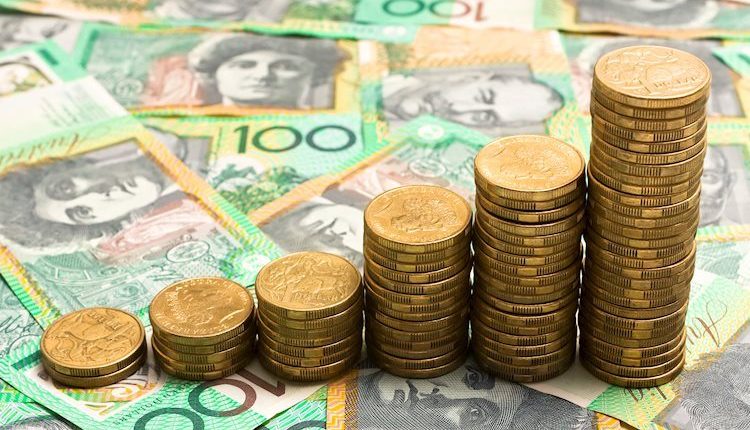- AUD/USD stands neutral around 0.6490 on Thursday.
- US-China trade war concerns and upcoming AI chip sanctions weigh on AUD/USD.
- Greenback’s weakness continues to support the Australian Dollar.
The AUD/USD stands mixed around 0.6495 in Thursday’s session, reversing early gains. The recent weakness in the US Dollar (USD) has helped keep the Aussie afloat. However, buyers have turned cautious amid the United States (US)-China trade war. The US is set to unveil further Artificial Intelligence (AI) chip sanctions against China on Monday, which is weighing on the AUD/USD, due to the risk-off market sentiment that has been triggered.
The Australian Dollar (AUD) has gained support due to weakness in the US Dollar, despite mixed Australian economic data and a hawkish Reserve Bank of Australia (RBA).
Daily digest market movers: Australian dollar pressured as US-China trade concerns linger.
- The AUD/USD benefited lately from the USD softness which seems to be in a consolidation period.
- The Greenback fundamentals remain, with markets pricing a less dovish Federal Reserve (Fed) and strong economic data limiting the USD’s losses.
- On the other side, the Aussie could see some gains by the RBA’s hawkishness but Australia’s mixed economic outlook might limit the upside.
- The markets are seeing the RBA’s first rate cut to come in Q2 of 2025, while continuing to be confident of a Fed cut in December.
- In addition, trade wards fears between the US and China might also affect the Aussie as China is one of its largest trade partners.
AUD/USD technical outlook: Outlook is negative in the short term despite signs of mild recovery
The AUD/USD pair remains under pressure as technical indicators continue to point to a bearish bias, with the Relative Strength Index (RSI) hovering below the 50 mark but the Moving Average Convergence Divergence (MACD) is showing some signs of bullish presence.However, for the short term, the outlook remains negative unless the pair manages to recover above the 20-day SMA. Should this level be breached, it could signal a potential trend reversal and open the door for further gains in the AUD/USD.
Australian Dollar FAQs
One of the most significant factors for the Australian Dollar (AUD) is the level of interest rates set by the Reserve Bank of Australia (RBA). Because Australia is a resource-rich country another key driver is the price of its biggest export, Iron Ore. The health of the Chinese economy, its largest trading partner, is a factor, as well as inflation in Australia, its growth rate and Trade Balance. Market sentiment – whether investors are taking on more risky assets (risk-on) or seeking safe-havens (risk-off) – is also a factor, with risk-on positive for AUD.
The Reserve Bank of Australia (RBA) influences the Australian Dollar (AUD) by setting the level of interest rates that Australian banks can lend to each other. This influences the level of interest rates in the economy as a whole. The main goal of the RBA is to maintain a stable inflation rate of 2-3% by adjusting interest rates up or down. Relatively high interest rates compared to other major central banks support the AUD, and the opposite for relatively low. The RBA can also use quantitative easing and tightening to influence credit conditions, with the former AUD-negative and the latter AUD-positive.
China is Australia’s largest trading partner so the health of the Chinese economy is a major influence on the value of the Australian Dollar (AUD). When the Chinese economy is doing well it purchases more raw materials, goods and services from Australia, lifting demand for the AUD, and pushing up its value. The opposite is the case when the Chinese economy is not growing as fast as expected. Positive or negative surprises in Chinese growth data, therefore, often have a direct impact on the Australian Dollar and its pairs.
Iron Ore is Australia’s largest export, accounting for $118 billion a year according to data from 2021, with China as its primary destination. The price of Iron Ore, therefore, can be a driver of the Australian Dollar. Generally, if the price of Iron Ore rises, AUD also goes up, as aggregate demand for the currency increases. The opposite is the case if the price of Iron Ore falls. Higher Iron Ore prices also tend to result in a greater likelihood of a positive Trade Balance for Australia, which is also positive of the AUD.
The Trade Balance, which is the difference between what a country earns from its exports versus what it pays for its imports, is another factor that can influence the value of the Australian Dollar. If Australia produces highly sought after exports, then its currency will gain in value purely from the surplus demand created from foreign buyers seeking to purchase its exports versus what it spends to purchase imports. Therefore, a positive net Trade Balance strengthens the AUD, with the opposite effect if the Trade Balance is negative.
Read the full article here

